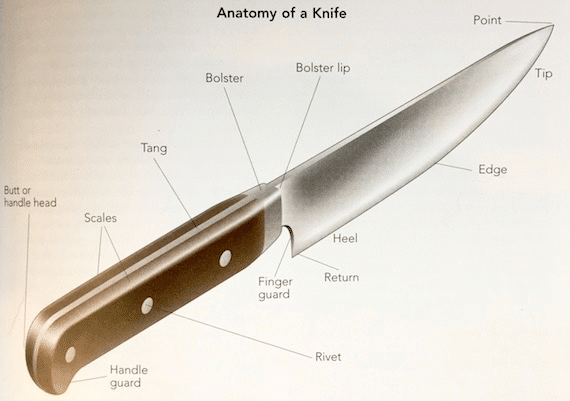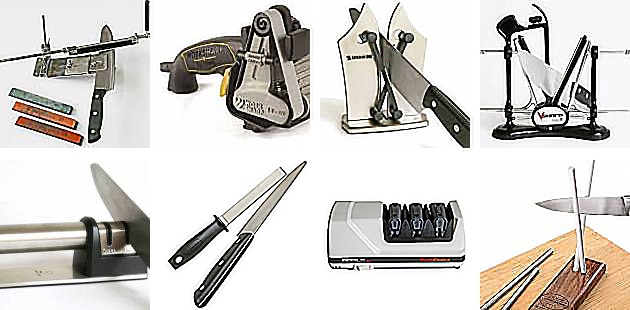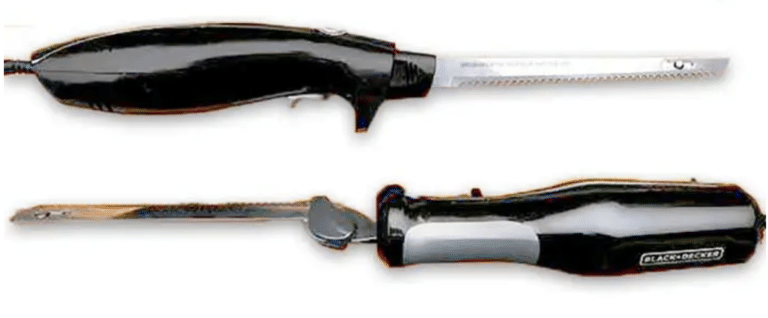Everything You Need to Know About Knives (3 Pages, 2 Articles)
Published On: 9/4/2019 Last Modified: 6/22/2024

Hone Your Chops With Our Ultimate Guide to Knives
The first crude knives were invented more than two and half million years ago. These tools improved our ability to survive, and, apart from our hands, they have evolved into the single most important tools in food preparation and cooking. Early knives were made of flint, but most modern kitchen blades are made of metal or ceramic. Chef’s knives may be sharp enough to cut the glaze on a dinner plate, but clam, oyster, and butter knives are made intentionally dull.
Click Here To Search Our Reviews And Ratings Of Tools, Toys, And Accessories
Regardless of what knife you use, cutting results from various forces working between the knife and the food. The cutting edge of a knife concentrates all of the force exerted by the user on a very narrow but long area. That force delivers a fine line of pressure that’s strong enough to sever tissues, slash through plant and animal cell walls, and even cut through bone.
Serrated knives further concentrate the force into a smaller area on the serrations, making cutting more swift. Sharper knives require less pressure and make cleaner cuts. This means that sharper knives damage fewer plant and animal tissues and cell walls, releasing fewer compounds from the cells, such as the sulfur compounds in onions that make us cry. Yep. If you want to shed the least tears when chopping onions, make sure you use a sharp knife.
Basic Knife Parts
All knives have essentially the same parts with a few exceptions for special knives. The illustration here identifies the basic components of a typical forged chef’s knife.
Forging, Stamping, and Tang
For a sturdy blade, look for knives that are fully forged and full tang, meaning they are made from a single piece of metal that is beaten to strengthen it, ground into shape, and extends from the blade to the back of the handle, where it is usually riveted into place. Stamped knives cut from sheets of metal are often less durable than forged knives. One of the best knives you can buy is a forged, full tang chef’s knife. For a much deeper dive into knife manufacturing methods and metallurgy, read our article on The Science of Knives.
How to Hold a Chef’s Knife
Most kitchens have a variety of knives for cleaving bones, paring strawberries, and slicing bread. But the chef’s knife is the most important one. This all-purpose knife handles routine chopping and slicing duties and has a slightly curved blade so you can rock it back and forth to chop quickly.
When handling knives, don’t be shy. Grab a chef’s knife like you mean it. Hold the handle but also hold the back edge of the knife right behind the heel of the blade. When your fingers hold some of the blade, you get more control over the knife. Stand with the knife perpendicular to the food you’re cutting. As you cut, keep the tip of the knife pointed down and let the blade and the weight of your body do most of the work. The knife should mostly move forward and backward to slice. It shouldn’t take much downward force.
With your other hand, hold and guide the food. Arch your fingers like an eagle’s claw to grasp the food, but tuck your thumb behind your fingers to keep from cutting yourself. It helps to rest the blade against your arched fingers. Then you can slowly move your arched hand and the knife blade together as you cut the food.
Aim to cut food into same-size pieces so they cook at the same rate. There’s also some research showing that different knife cuts, such as long slices on an angle, expose more surface area and release more flavorful compounds from the food. So try to cut the food the way it’s suggested in any given recipe. It makes a difference!
Basic Knife Care and Sharpening
To keep your blades at their sharpest, avoid extreme downward pressure and twisting, and cut only on knife-friendly surfaces like wood and plastic. These materials absorb some of the knife blade and delay dulling. They also make cutting steadier, swifter, and safer. Glass, stone, and metal surfaces will dull your blades quickly. Hone your knife every few uses, and sharpen your knives whenever they are too dull to cut cleanly through the skin of a tomato without squashing the tomato. Click here to find out how to properly hone and sharpen a knife. And click here for our guide to the best knife sharpeners.

Here’s what a chipped knife looks like. This chipping happened while trying to cut through turkey bones at Thanksgiving. To avoid chipping your knife, particularly when cutting between bones when carving a turkey or other bird, aim your knife directly between the bones, and keep the pressure downward and forward. Avoid twisting the knife from side to side against the hard bones, which could cause the blade to chip.
To safely cut through thick-skinned vegetables, particularly those with hardened stems such as winter squash, slice off the hardened ends first, then cut the through the vegetable with downward and foward pressure, avoiding any twisting from side to side. For a helpful video on how to avoid chipping your knife, click here to watch master bladesmith Bob Kramer’s explanation on YouTube.
You can also soften the skin by poking a few holes in large winter squash such as butternut, then microwaving the perforated squash for 1 to 2 minutes. Microwaving softens the skin enough so that you can peel it with a vegetable peeler. Then slicing is a piece of cake.
When it comes to cleaning, most knives are best washed by hand to avoid discoloring the blade and damaging the handle, especially is the handle is made of wood. Avoid the dishwasher. The high heat of a dishwasher can cause microscopic movement in molecules in metal blades and the salty detergent can weaken the steel. The chemicals might also create some spotting, which can later become rust.
As for storage, you should keep your knives in slots, sleeves, racks, or on a magnetic strip to protect the cutting edges from damage and dulling. If you want to dull your knives in a hurry, keep them in kitchen drawer full of other knives and gadgets.
What To Look For When Selecting Knives
Unless you’re Bigshot Chef at Bigshot Restaurant, there’s no reason to buy a full set of umpteen different knives. Just be sure to stock 3 top-quality blades: a chef’s knife (for chopping, slicing, dicing, and gesticulating when talking with guests), a paring knife (for you guessed it), and a serrated knife (for bread and tomatoes).
A great chef’s knife makes food prep so much easier. If you’re going to spend a chunk of money on a knife, here’s where it should go. What size? If you’re big and strong, you’ll probably be comfortable with an 8 or 10 inch blade or even a 12 inch if you’re serious. If you’re smaller in stature or a control freak, you may want to use a smaller, lighter chef’s knife like a 6 inch knife or even a 5 inch santoku (Japanese all-purpose knife).
Size matters but not as much as feel. You have to feel comfortable holding the knife, and all knives differ in weight distribution, balance, grip contour, materials, and construction. Before you buy anything, go somewhere (yes, out of your house), and pick up a few knives. A good knife should make you want to use it. It should feel comfortable and be easy to grip. The right knife for you is the knife that feels best in your hand.
Some of our favorite knives right now are coming from Günther Wilhem. The GW Lightning ProCut and Premier ProCut knives are well balanced, durable, sharpen easily, retain their edges well, and work like dogs in the kitchen. Plus, they are drop dead gorgeous. Click here to read more about Gunther Wilhem knives.
And check out the links below for everything else you will ever want to know about knives from metallurgical science to using a whetstone to buying a decent electric knife for slicing brisket.

All You Need To Know About How To Sharpen And Hone Knives
Sharp knives cut. Dull knives slip. Stay safe by keeping your knife sharp. Here's a guide to honing and sharpening your knife using a honing steel and sharpening stones.How to Buy the Best Kitchen Knives
At least one good chef's knife is the most essential tool in any kitchen. Does that mean you need to spend hundreds of dollars on an entire set of knives? No. Just a few good quality knives are all you really need.Electric Knives That Make The Cut
We test, compare, rate, and review popular electric knives. An electric knife makes quick work of slicing big hunks of meat like turkeys, whole packer briskets, beef tenderloin, prime rib, crown roast of pork, and hams. They are great at making even cuts.Related articles
- Myth: Stabbing Meat with a Thermometer, Fork, or Knife Will Drain it of Vital Juices
- Food Safety From The Store To The Table In The Age Of COVID-19
- A Guide to The Best Knife Sharpeners
- How to Buy the Best Kitchen Knives
- Electric Knives That Make The Cut
- All You Need To Know About How To Sharpen And Hone Knives
- The Science of Knives
- BBQ And Kitchen Tools, Toys, And Accessories Rated And Reviewed (23 Pages)
Related reviews
- Gunter Wilhelm Premier ProCut 8 Inch Chef Knife Review
- The Rapala Fillet Knife Is Cheap, Sharp And Versatile
- The Messermeister Meridian Elite Knife Kit Travels Well







High quality websites are expensive to run. If you help us, we’ll pay you back bigtime with an ad-free experience and a lot of freebies!
Millions come to AmazingRibs.com every month for high quality tested recipes, tips on technique, science, mythbusting, product reviews, and inspiration. But it is expensive to run a website with more than 2,000 pages and we don’t have a big corporate partner to subsidize us.
Our most important source of sustenance is people who join our Pitmaster Club. But please don’t think of it as a donation. Members get MANY great benefits. We block all third-party ads, we give members free ebooks, magazines, interviews, webinars, more recipes, a monthly sweepstakes with prizes worth up to $2,000, discounts on products, and best of all a community of like-minded cooks free of flame wars. Click below to see all the benefits, take a free 30 day trial, and help keep this site alive.
Post comments and questions below
1) Please try the search box at the top of every page before you ask for help.
2) Try to post your question to the appropriate page.
3) Tell us everything we need to know to help such as the type of cooker and thermometer. Dial thermometers are often off by as much as 50°F so if you are not using a good digital thermometer we probably can’t help you with time and temp questions. Please read this article about thermometers.
4) If you are a member of the Pitmaster Club, your comments login is probably different.
5) Posts with links in them may not appear immediately.
Moderators